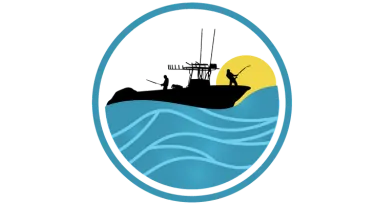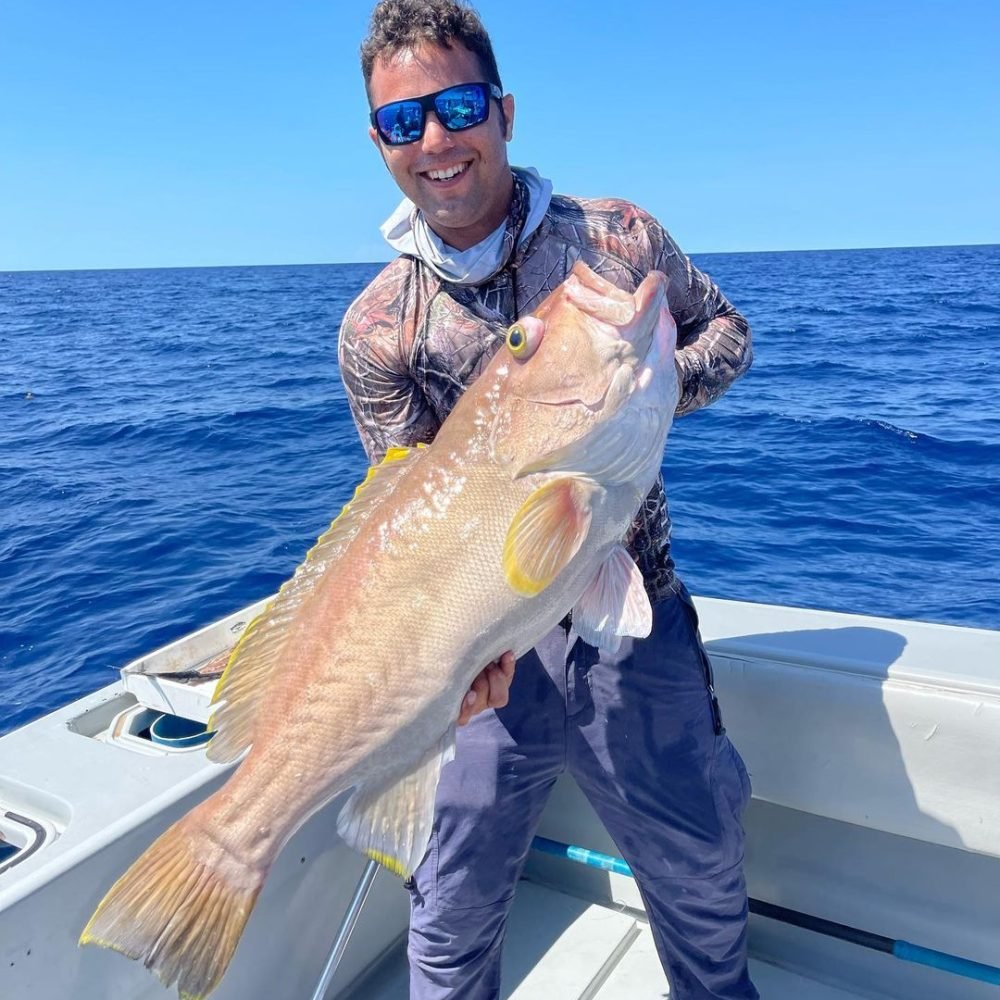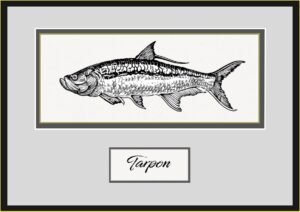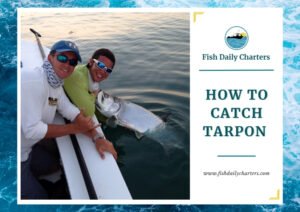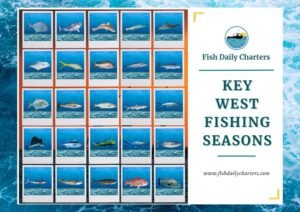Anglers frequently discuss the advantages of nearshore and offshore fishing styles. These two popular methods offer different experiences. Each has its own challenges and rewards. Some people are attracted to nearshore fishing for its calm waters and closeness to the coast. It is an excellent choice for beginners or individuals in search of a leisurely adventure. Offshore fishing is popular among adrenaline junkies and seasoned fishers. They enjoy the thrill of the deep waters. They also get to catch bigger, tougher fish.
Knowing the differences between nearshore and offshore is important. Are you a beginner wanting a relaxed day on the water? Or, an experienced angler seeking a thrilling deep-sea fishing challenge? Understanding the details of each style will help you choose well. This guide will give you the info to pick the best fishing trip for your next deep-sea adventure.

How Does the Gear and Equipment Differ for Nearshore vs. Offshore?
Nearshore Fishing Gear
When it comes to nearshore, the equipment tends to be lighter and more flexible than what’s used for offshore trips:
- Rods and Reels: Medium to heavy tackle, perfect for larger fish and longer fights.
- Lines: Medium lines, typically 20-50 lb test, to handle the strength of nearshore species.
- Lures and Baits: Larger trolling lures, jigs, and live bait like sardines, mackerel, and squid.
Offshore Fishing Gear
Nearshore needs lighter tackle and gear designed for shallower waters. The waters are close to the shore and have changing conditions. That’s why it’s lighter and more flexible than offshore fishing gear:
- Rods and Reels: Heavy-duty tackle designed for the biggest fish. A 50-80 pound class rod with a high-capacity reel is typical.
- Lines: Heavy lines, often 50-100 lb test, to handle the strength of large fish.
- Lures and Baits: Large trolling lures, jigs, and live bait like sardines, mackerel, and squid.
- Terminal Tackle: Includes circle hooks, J-hooks, treble hooks, sinkers, weights, and heavy-duty swivels.
- Tools: Pliers, a landing net, a gaff, a tackle box, and a valid license. A fish finder or GPS helps locate fish and navigate the waters.
- Safety Gear: Life jackets, first aid kits, and emergency signaling devices are essential for safety on the open ocean.
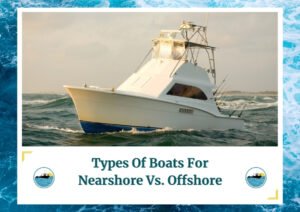
Types of Boats for Nearshore vs. Offshore
Nearshore Fishing Boats
Nearshore boats have features such as shallow drafts, sturdy hulls, and maneuverability. These features help them navigate the shallow and sometimes rocky waters close to shore. Gear, like rod holders, live wells, and fish finders, boosts fishing in coastal areas.
Nearshore fishing boats are usually smaller. So, they are cheaper and easier to move and store than larger crafts. Smaller boats allow for easier access to shallow coves, inlets, and estuaries. Many of the boats are designed for comfort. They have cushioned seating, storage compartments, and even small cabins for bad weather.
- Center Consoles: Versatile boats that handle both nearshore and inshore waters easily.
- Bay Boats: Slightly larger than flats boats, suitable for many different environments.
- Catamarans: Known for stability and a smooth ride due to their twin hulls.
Offshore Fishing Boats
Offshore fishing boats have advanced tech and safety features. They help keep the anglers safe and comfy on long trips in the ocean. These boats often have larger fuel tanks and extra storage space. This is to meet the needs of long trips far from shore.
Offshore fishing boats are designed with stabilizers and reinforced hulls. These features give stability and durability in rough waters. Many boats have advanced navigation and communication equipment. They make sure the crew is able to navigate and communicate safely.
- Sportfishing Yachts: Designed for long journeys and equipped with amenities for extended trips.
- Center Console Boats: Larger versions with powerful engines are perfect for further out trips.
- Convertible Boats: Combine luxury with functionality, featuring cabins and ample storage.
- Walkaround Boats: Offer both fishing capabilities and comfort, with cabins and sleeping quarters.
- Express Boats: Sporty and powerful, designed for serious outings with open cockpits and small cabins.
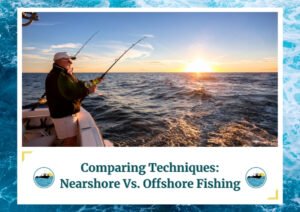
Comparing Techniques: Nearshore vs. Offshore Fishing
Anglers must understand the different fishing techniques for both nearshore waters and offshore environments. Nearshore fishing uses simple methods and gear. They are well-suited for the calm, shallow waters near the coast. By contrast, offshore fishing needs advanced techniques and gear. They are designed for the challenges of deep-sea fishing conditions. Let’s examine the specific techniques used in both nearshore and offshore fishing.
Nearshore Fishing Techniques
When near the shore, use techniques that work well in the deeper and choppy waters, such as:
- Trolling: Dragging lures or baited hooks behind a moving boat. This attracts fast-swimming fish like mackerel and Spanish mackerel.
- Bottom Fishing: If you’re looking to reel in snapper and grouper near the ocean floor, try using weighted rigs.
- Jigging: Moving a weighted bait up and down in the water to attract fish like cobia and amberjack.
Offshore Fishing Techniques
Offshore fishing uses different techniques to target the wide range of species found in deep-sea waters:
- Trolling: Dragging lures or baited hooks behind a moving boat to attract fast-swimming fish like marlin, tuna, and wahoo.
- Bottom Fishing: Using weighted rigs to target species near the ocean floor, such as grouper and snapper.
- Jigging: Moving a weighted bait up and down in the water to attract fish like amberjack and Spanish mackerel.
- Live Bait: Using live bait like sardines, mackerel, or squid to attract larger predatory fish.
- Drift Fishing: Drifting with the current or wind while using baits or lures to cover a wide area, ideal for targeting species like tuna and kingfish.
- Deep Dropping: Involves lowering baits to depths over 300 feet. This is done using heavy weights. It targets species like swordfish and tilefish.
- Kite Fishing: Kites are used to suspend bait at the surface of the water. This gives the bait a natural appearance and attracts surface-feeding fish like sailfish.
- Chunking: Chopping bait into pieces and casting them into the water to attract fish, commonly used to lure large schools of tuna.
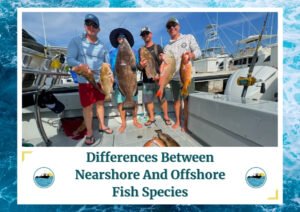
Differences Between Nearshore and Offshore Fish Species
Knowing the differences between nearshore and offshore fish will improve your fishing trips. These differences influence the fish you may hook. They also affect the techniques and gear you’ll need. Here are the main differences to consider between nearshore and offshore fish species:
Nearshore Fishing Target Species
Nearshore fishing is all about catching different types of fish that are found close to the shore, usually within view of land. Some popular species to reel in are:
- King Mackerel: Known for their strong fighting skills, found in deeper coastal waters.
- Spanish Mackerel: Fast and aggressive fish that provide a fun and challenging catch.
- Cobia: Strong fighters found around nearshore reefs and structures like buoys and wrecks.
- Black Sea Bass: A popular target for bottom fishing in shallow areas.
- Tarpon: Found during their migration. Tarpon are known for their impressive size and acrobatic fights.
Offshore Fishing Target Species
The goal of offshore fishing trips is to reel in large, powerful fish species that are usually found in the deeper waters. Some of the commonly popular species are:
- Yellowfin Tuna: Known for their incredible speed and strength, making them a prized catch.
- Blue Marlin: Favored for their impressive size and acrobatic fights. Often found in tropical and subtropical waters.Wahoo: Fast and strong fish known for their excellent flavor.
- Red Snapper: Found near underwater structures, these fish are highly valued for their firm and tasty meat.
- Sailfish: Famous for their incredible speed and spectacular aerial displays during the fight.
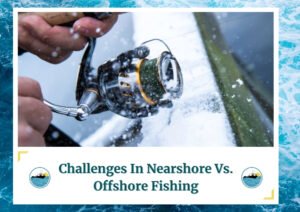
Challenges in Nearshore vs. Offshore Fishing
Both nearshore fishing and offshore fishing have their own unique challenges. Knowing the exact difficulties of each style makes your fishing journeys better. Fishing, whether nearshore or offshore, comes with its own set of challenges. Let’s take a look at the main difficulties you might face in both nearshore and offshore fishing.
Nearshore Fishing Challenges
- Weather and Sea Conditions: Dealing with rougher waters and stronger currents.
- Navigation: Longer than inshore, distances need careful navigation.
- Fish Behavior: Fish are larger and more challenging to reel in than inshore species.
Offshore Fishing Challenges
- Weather and Sea Conditions: Dealing with rough seas, strong currents, and unpredictable weather.
- Navigation: Longer distances need precise navigation and knowledge of the area.
- Equipment: Managing and maintaining heavy-duty equipment designed for large game fish.
- Physical Demands: Battling large, powerful fish is physically demanding and exhausting.
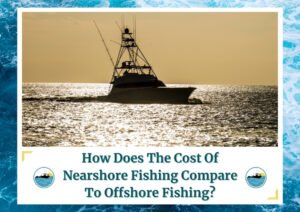
How Does the Cost of Nearshore Fishing Compare to Offshore Fishing?
When planning a fishing trip, cost is an important aspect to consider. Nearshore trips and offshore fishing trips vary in cost. The lists below show how nearshore fishing costs compare to offshore fishing costs. They will help you understand what to expect for each type of adventure.
Nearshore Fishing Costs
- Fuel Costs: Reasonable fuel costs because trips are closer to the coast.
- Equipment Costs: The tackle and gear are generally less expensive.
- Charter Costs: Guided trips are usually more affordable.
- Maintenance: Smaller boats and simpler gear need less maintenance.
Offshore Fishing Costs
- Higher Fuel Costs: Longer distances traveled, and larger boats consume more fuel.
- Equipment Costs: Heavy-duty gear, strong tackle, and specialized equipment are more expensive.
- Charter Costs: Fishing charters are more costly because of the length and equipment needed.
- Maintenance: Larger boats and complex equipment need more maintenance.
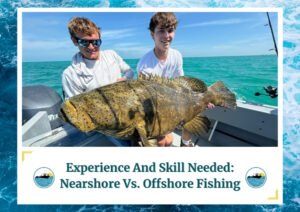
Experience and Skill Needed: Nearshore vs. Offshore Fishing
Choosing between nearshore and offshore fishing depends on your experience and skill level. Nearshore fishing is perfect for beginners. Its waters are calm, and its techniques are simple. Offshore fishing needs more advanced skills and knowledge. This type of fishing has challenging conditions and larger catches. Let’s compare the experience and skills needed for each type of fishing.
Nearshore Fishing Experience and Skill Level
- Intermediate Skills: You should have some experience and know-how when it comes to techniques.
- Techniques: More difficult than inshore fishing but easier than offshore fishing.
- Physical Demands: More physically demanding than inshore fishing but less than offshore fishing.
- Trip Duration: Moderate trip durations allow for good practice and learning.
Offshore Fishing Experience and Skill Level
- Advanced Skills: A lot of experience and knowledge is essential.
- Techniques: Complicated techniques and equipment handling.
- Physical Demands: More physically demanding, with longer fights and rougher conditions.
- Trip Duration: Longer trips mean more stamina and endurance are needed.

What Are the Pros and Cons of Nearshore Fishing Vs. Offshore Fishing?
When deciding between nearshore and offshore fishing, it’s important to weigh the pros and cons of each. Nearshore fishing offers a more relaxed experience. Offshore fishing is an adventurous challenge. To help you choose the best option for your next trip, we’ve outlined the advantages and disadvantages of both styles. This will help you decide which type of fishing suits you best:
Nearshore Fishing Pros
- Accessibility: Quicker and easier access to fishing spots.
- Cost: Usually, trips and equipment cost less.
- Intermediate-Friendly: Great for anglers with some experience.
- Moderate Waters: These waters are calmer and more comfortable.
Nearshore Fishing Cons
- Moderate-Sized Fish: Targets smaller species.
- Limited Adventure: Less thrill compared to the open ocean experience of offshore fishing.
Offshore Fishing Pros
- Larger Fish: Targets the biggest fish, offering a thrilling experience.
- Adventure: The excitement of the open ocean and challenging conditions.
- Diverse Species: Opportunities to catch a wide variety of large fish.
Offshore Fishing Cons
- Cost: Higher costs for trips and specialized equipment needed.
- Accessibility: Longer travel time and preparation need extra effort.
- Physical Demands: More physically demanding and challenging.
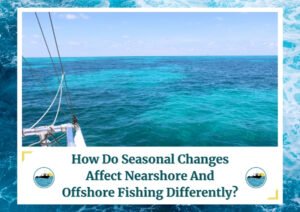
How Do Seasonal Changes Affect Nearshore and Offshore Fishing Differently?
Fishing patterns change with the seasons. They affect fish nearshore and offshore, changing how fish act and their numbers. They also affect overall fishing conditions. Understanding these changes will improve your overall fishing experience. They will help you plan your trip better. Here’s how seasonal changes affect nearshore and offshore fishing differently:
Nearshore Fishing Seasonal Changes
- Spring and Summer: Warmer waters bring more activity and diverse species.
- Fall and Winter: Cooler temperatures reduce fish activity but offer interesting opportunities for certain species.
Offshore Fishing Seasonal Changes
- Spring and Summer: Prime seasons for many species, with active migrations happening.
- Fall and Winter: Some species move to deeper waters, requiring longer trips to reach them.
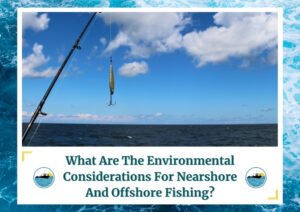
What Are the Environmental Considerations for Nearshore and Offshore Fishing?
When planning a fishing trip, think about how your style impacts the environment. Nearshore and offshore fishing styles have different environmental effects that affect marine ecosystems. Knowing these factors will help you make eco-friendly decisions. Reducing your overall impact on the environment. Here, we discuss the main environmental considerations for both nearshore and offshore trips.
Nearshore Fishing Environmental Considerations
- Habitat Protection: Avoid damaging sensitive habitats like coral reefs and seagrass beds.
- Pollution: Minimize pollution by disposing of trash and gear safely.
- Catch and Release: Practice responsible catch and release to preserve fish populations.
Offshore Fishing Environmental Considerations
- Overfishing: Follow the catch limits and regulations to prevent overfishing.
- Bycatch: Reduce bycatch by using appropriate gear and techniques.
- Marine Debris: Avoid leaving behind gear and tackle that will harm marine life.
- Eco-Friendly Practices: Use eco-friendly tackle and gear to minimize environmental impact.
Conclusion
Your choice between offshore and nearshore trips depends on your preferences, skills, and trip goals. Both options offer unique experiences and challenges. If you have the equipment and some experience, nearshore fishing may be the way to go. It offers a moderate challenge and a diverse range of catches. But, if you’re a thrill-seeker and a skilled angler who wants adventure and big catches, offshore fishing might be for you.
If you enjoy the variety and excitement of nearshore waters, Fish Daily Charters has trips just for you. If you love the thrill of deep-sea offshore fishing, we offer those too. Our skilled captains and fully-equipped boats provide a fun and successful fishing trip. Book your next fishing adventure with Fish Daily Charters today for an unforgettable time on the water.
